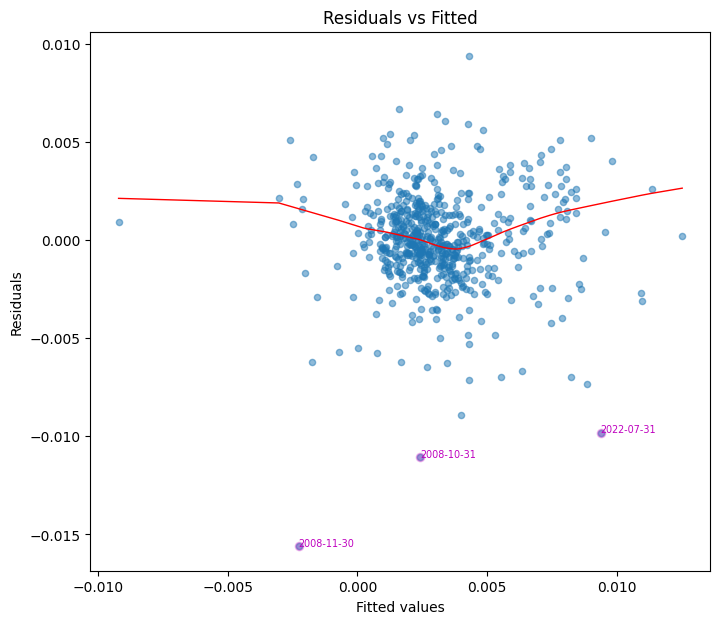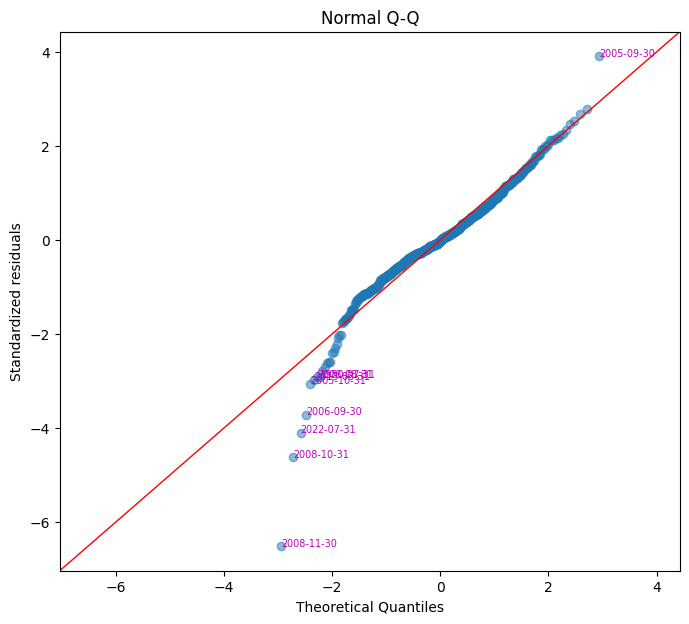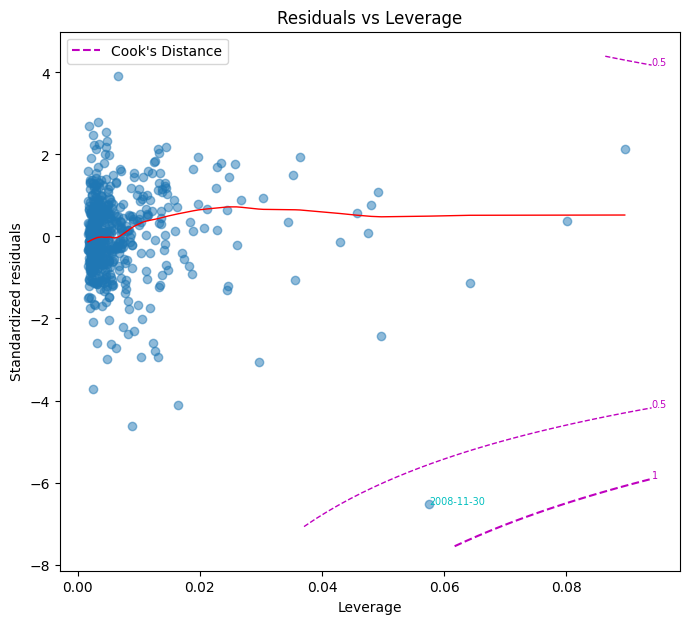Linear Regression Diagonostics#
In economics, the majority is always wrong - John Kenneth Galbraith
For a linear regression model to produce reliable and interpretable results, it must satisfy certain assumptions. Diagnosing potential issues such as heteroskedasticity, multicollinearity, omitted variables, and influential data points is important for model validity. We explore key diagnostic tests for linear regression, including methods for detecting violations of assumptions, evaluating the impact of outliers, and assessing model fit through residual plots. Additionally, we discuss techniques for robust standard errors when assumptions are violated, such as heteroskedasticity- and autocorrelation-consistent (HAC) estimators.
# By: Terence Lim, 2020-2025 (terence-lim.github.io)
import numpy as np
import pandas as pd
import pandas as pd
from pandas import DataFrame, Series
import matplotlib.pyplot as plt
import patsy
import statsmodels.formula.api as smf
from statsmodels.stats.outliers_influence import variance_inflation_factor
from finds.readers import Alfred
from finds.utils import plot_fitted, plot_leverage, plot_scale, plot_qq
from secret import credentials
VERBOSE = 0
# matplotlib qt
alf = Alfred(api_key=credentials['fred']['api_key'])
For this analysis, we retrieve monthly Consumer Price Index (CPI) data as the dependent (endogenous) variable and Producer Price Index (PPI) data as the independent (exogenous) variable. The model uses the monthly differences of the logarithms of both series to account for changes over time.
# difference of logs of CPI and PPI monthly series from FRED
series_id, freq, start = 'CPIAUCSL', 'M', 0 #19740101
exog_id = 'WPSFD4131'
data = pd.concat([alf(s, start=start) for s in [series_id, exog_id]], axis=1)
data.index = pd.DatetimeIndex(data.index.astype(str))
data = np.log(data).diff().dropna() # model the changes in logs of the series
DataFrame.from_dict({s: alf.header(s) for s in [series_id, exog_id]},
orient='index', columns=['Description'])
| Description | |
|---|---|
| CPIAUCSL | Consumer Price Index for All Urban Consumers: ... |
| WPSFD4131 | Producer Price Index by Commodity: Final Deman... |
Model assumptions#
A valid linear regression model must satisfy the following assumptions:
Linearity: The expected value of \( y_i \) follows a linear function of the independent variables:
$\( E[y_i] = b_0 + b_1 x_{i1} + ... + b_k x_{ik} \)$Exogeneity: The explanatory variables \( \{x_{i1} ,...,x_{ik} \} \) are non-stochastic and not correlated with the error term.
Homoscedasticity: The variance of the dependent variable remains constant:
$\( Var(y_i) = \sigma^2 \)$Independence: The observations \( \{ y_i \} \) are independent of each other.
Normality: The error terms follow a normal distribution.
When assumptions 1-4 hold, the least squares estimator:
Provides an unbiased estimate of the regression coefficients:
$\( b = (X' X)^{-1} X' y \)$Has a variance-covariance matrix:
$\( Var(b) = \sigma^2 (X' X)^{-1} \)$The standard error for each coefficient \( b_j \) is:
$\( se(b_j) = \sigma \sqrt{(X' X)^{-1}_{[j+1,j+1]}} \)$
When all five assumptions hold, the least squares estimator follows a normal distribution, enabling valid statistical inference.
# Run Linear Regression (with exog and 2 lags)
dmf = (f'{series_id} ~ {series_id}.shift(1) + {series_id}.shift(2) + {exog_id}.shift(1)')
model = smf.ols(formula=dmf, data=data).fit()
print(model.summary())
OLS Regression Results
==============================================================================
Dep. Variable: CPIAUCSL R-squared: 0.453
Model: OLS Adj. R-squared: 0.451
Method: Least Squares F-statistic: 167.5
Date: Sun, 02 Mar 2025 Prob (F-statistic): 4.43e-79
Time: 22:25:01 Log-Likelihood: 2815.2
No. Observations: 610 AIC: -5622.
Df Residuals: 606 BIC: -5605.
Df Model: 3
Covariance Type: nonrobust
======================================================================================
coef std err t P>|t| [0.025 0.975]
--------------------------------------------------------------------------------------
Intercept 0.0009 0.000 6.276 0.000 0.001 0.001
CPIAUCSL.shift(1) 0.5821 0.041 14.199 0.000 0.502 0.663
CPIAUCSL.shift(2) -0.0479 0.041 -1.174 0.241 -0.128 0.032
WPSFD4131.shift(1) 0.2011 0.036 5.609 0.000 0.131 0.271
==============================================================================
Omnibus: 116.912 Durbin-Watson: 2.051
Prob(Omnibus): 0.000 Jarque-Bera (JB): 584.706
Skew: -0.752 Prob(JB): 1.08e-127
Kurtosis: 7.555 Cond. No. 522.
==============================================================================
Notes:
[1] Standard Errors assume that the covariance matrix of the errors is correctly specified.
Heteroskedasity and HAC robust errors#
If the variance of residuals is not constant (heteroskedasticity), the usual Ordinary Least Squares (OLS) standard error formula, \( \sigma^2 (X' X)^{-1} \), no longer holds. While OLS coefficient estimates remain consistent, their standard errors may be misestimated. A more general form of the variance-covariance matrix is:
where different choices of \( \Omega \) provide robust standard error estimators.
White’s (1980) heteroskedasticity-consistent estimator (also known as the sandwich estimator) uses the diagonal of squared residuals.
Alternative estimators account for leverage effects in the design matrix.
If error terms exhibit serial correlation, standard heteroskedasticity-robust errors may still be misleading. Newey and West (1987) introduced the Heteroskedasticity and Autocorrelation Consistent (HAC) estimator, which applies a weighting scheme to correct for autocorrelation. The truncation parameter for lag selection is often chosen as:
where autocorrelation coefficients are weighted as follows:
robust = model.get_robustcov_results(cov_type='HAC', use_t=None, maxlags=0)
print(robust.summary())
OLS Regression Results
==============================================================================
Dep. Variable: CPIAUCSL R-squared: 0.453
Model: OLS Adj. R-squared: 0.451
Method: Least Squares F-statistic: 108.8
Date: Sun, 02 Mar 2025 Prob (F-statistic): 2.25e-56
Time: 22:25:01 Log-Likelihood: 2815.2
No. Observations: 610 AIC: -5622.
Df Residuals: 606 BIC: -5605.
Df Model: 3
Covariance Type: HAC
======================================================================================
coef std err t P>|t| [0.025 0.975]
--------------------------------------------------------------------------------------
Intercept 0.0009 0.000 5.779 0.000 0.001 0.001
CPIAUCSL.shift(1) 0.5821 0.074 7.903 0.000 0.437 0.727
CPIAUCSL.shift(2) -0.0479 0.053 -0.902 0.367 -0.152 0.056
WPSFD4131.shift(1) 0.2011 0.055 3.652 0.000 0.093 0.309
==============================================================================
Omnibus: 116.912 Durbin-Watson: 2.051
Prob(Omnibus): 0.000 Jarque-Bera (JB): 584.706
Skew: -0.752 Prob(JB): 1.08e-127
Kurtosis: 7.555 Cond. No. 522.
==============================================================================
Notes:
[1] Standard Errors are heteroscedasticity and autocorrelation robust (HAC) using 0 lags and without small sample correction
Multicollinearity and variance inflation factors#
Multicollinearity arises when explanatory variables are highly correlated, leading to unstable coefficient estimates. The Variance Inflation Factor (VIF) quantifies the degree of multicollinearity by measuring how much a predictor’s variance is inflated due to correlation with other predictors:
where \( R^2_i \) is obtained by regressing \( X_i \) on all other predictors.
A VIF > 5 or 10 suggests that the variable is highly collinear with other explanatory variables, potentially leading to large standard errors and unreliable estimates.
Y, X = patsy.dmatrices(dmf + ' - 1', data=data) # exclude intercept term
print("Variance Inflation Factors")
Series({X.design_info.column_names[i]: variance_inflation_factor(X, i)
for i in range(X.shape[1])}, name='VIF').to_frame()
Variance Inflation Factors
| VIF | |
|---|---|
| CPIAUCSL.shift(1) | 3.414717 |
| CPIAUCSL.shift(2) | 3.404137 |
| WPSFD4131.shift(1) | 2.285974 |
Omitted variables#
Leaving out an important variable from the regression model can lead to biased estimates. The consequences are:
Bias in Included Variables: If the omitted variable is correlated with included variables, their regression coefficients will capture some of its effect, leading to inconsistent estimates.
Inflated Residual Variance: The estimated residuals will include both true shocks and the effects of the omitted variable, reducing model accuracy.
Conversely, including an extraneous (irrelevant) variable does not introduce bias but increases standard errors, making it harder to detect significant effects.
Residual diagnostics#
Residual plots help evaluate model fit, identify outliers and detect potential specification issues.
An ideal model would have residuals that are not systematically related to any of the included explanatory variables. Standardized residuals may alternatively be used so that the magnitude of deviation is more apparent.
Residuals vs fitted plot#
This plot assesses whether residuals exhibit nonlinear patterns. Ideally, residuals should be randomly scattered around zero, with no discernible trend. A systematic pattern suggests model misspecification or omitted variables.
# Plot residuals and identify outliers
fig, ax = plt.subplots(clear=True, figsize=(8,7))
z = plot_fitted(fitted=model.fittedvalues,
resid=model.resid,
ax=ax)
print("Residual Outliers")
z.to_frame().T
Residual Outliers
| date | 2022-07-31 | 2008-10-31 | 2008-11-30 |
|---|---|---|---|
| outliers | -0.009815 | -0.011066 | -0.015599 |

Normal QQ plot#
A quantile-quantile (Q-Q) plot compares residuals to a normal distribution. If residuals are normally distributed, data points should align along a 45-degree reference line. Outliers may appear as deviations from this line, indicating potential issues such as a heavy-tailed distribution.
fig, ax = plt.subplots(clear=True, figsize=(8,7))
plot_qq(model.resid, ax=ax)
/home/terence/env3.11/lib/python3.11/site-packages/statsmodels/graphics/gofplots.py:1043: UserWarning: color is redundantly defined by the 'color' keyword argument and the fmt string "b" (-> color=(0.0, 0.0, 1.0, 1)). The keyword argument will take precedence.
ax.plot(x, y, fmt, **plot_style)
| residuals | standardized | |
|---|---|---|
| date | ||
| 2008-11-30 | -0.015599 | -6.511279 |
| 2008-10-31 | -0.011066 | -4.619178 |
| 2022-07-31 | -0.009815 | -4.097059 |
| 2006-09-30 | -0.008903 | -3.716483 |
| 2005-10-31 | -0.007321 | -3.056102 |
| 2013-03-31 | -0.007108 | -2.967065 |
| 2008-08-31 | -0.007003 | -2.923170 |
| 1980-07-31 | -0.006997 | -2.920733 |
| 2005-09-30 | 0.009362 | 3.907884 |

Scale-location plot#
This plot checks for homoscedasticity (constant variance). Residuals should be evenly spread across predictor values. A funnel-shaped pattern suggests heteroskedasticity, requiring robust standard errors.
fig, ax = plt.subplots(clear=True, figsize=(8,7))
plot_scale(model.fittedvalues, model.resid, ax=ax)
array([579, 414, 415])

Leverage and influential points#
Certain data points can disproportionately affect regression estimates. The projection matrix from the least squares estimator, also called the hat matrix, \( H = X(X^T X)^{-1}X^T\) identifies leverage points, where the diagonal element \( h_{ii} \) measures the influence of the \( i \)-th observation.
A point may have high leverage but not necessarily influence the regression results significantly. Cook’s Distance measures influence based on both residual magnitude and leverage:
where:
\( p \) is the number of regression parameters.
\(t_i = \frac{\hat{\epsilon}_i}{\hat{\sigma} (1-h_{ii})}\) is the studentized residual, which accounts for non-constant variance.
\(\hat{\sigma} = \sqrt{\sum_{j=1}^n \hat{\epsilon}_j^2/n}\).
D_i > 1 $ suggests an influential point that may need further investigation. The Residuals vs Leverage plot helps visualize these influential points.
fig, ax = plt.subplots(clear=True, figsize=(8,7))
plot_leverage(model.resid, model.get_influence().hat_matrix_diag,
model.get_influence().cooks_distance[0],
ddof=len(model.params), ax=ax)
| influential | cook's D | leverage | |
|---|---|---|---|
| date |

References:
White, Halbert (1980). “A Heteroskedasticity-Consistent Covariance Matrix Estimator and a Direct Test for Heteroskedasticity”. Econometrica. 48 (4): 817–838.
Newey, Whitney K., and Kenneth D. West. 1987. “A Simple, Positive Semi-Definite, Heteroskedasticity and Autocorrelation Consistent Covariance Matrix.” Econometrica 55: 703–8.
https://library.virginia.edu/data/articles/diagnostic-plots
FRM Part I Exam Book Quantitative Analysis Ch 9